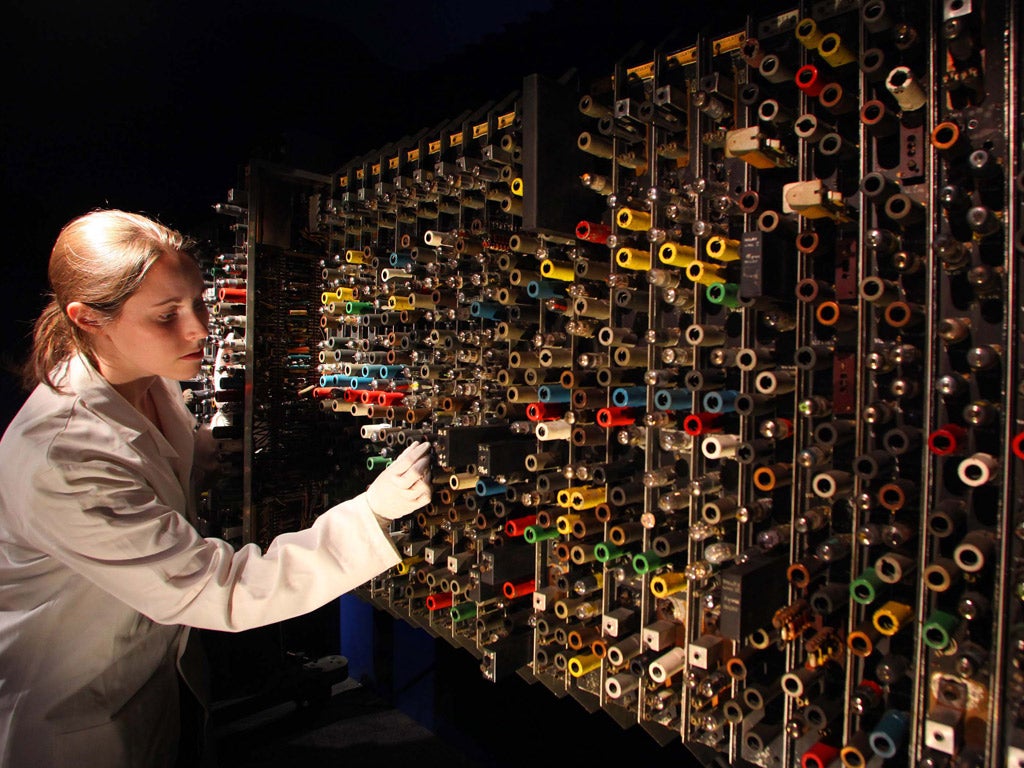Code Breaker: Alan Turing's Life and Legacy, Science Museum, London
Turing gets rebooted - 50 years too late

Your support helps us to tell the story
From reproductive rights to climate change to Big Tech, The Independent is on the ground when the story is developing. Whether it's investigating the financials of Elon Musk's pro-Trump PAC or producing our latest documentary, 'The A Word', which shines a light on the American women fighting for reproductive rights, we know how important it is to parse out the facts from the messaging.
At such a critical moment in US history, we need reporters on the ground. Your donation allows us to keep sending journalists to speak to both sides of the story.
The Independent is trusted by Americans across the entire political spectrum. And unlike many other quality news outlets, we choose not to lock Americans out of our reporting and analysis with paywalls. We believe quality journalism should be available to everyone, paid for by those who can afford it.
Your support makes all the difference.The popular attitude to very brainy people is that they must be, by definition, odd: insular, distracted, almost certainly on the autistic spectrum. To the Science Museum's great credit, one outcome of its centenary tribute to the ultimately tragic maths genius Alan Turing is to humanise him. You emerge from this excellent free exhibition – financed by Google – with the sense that some small redress has been made, albeit 50 years late, for the appallingly shabby treatment meted out to one of the greatest minds of the 20th century.
Turing's name summons up in most people a single image: that of the tweed-jacketed wartime codebreaker, beavering in top-secret isolation at Bletchley Park. There he was a cockerel among chickens – his workforce being largely Wrens – racing to unlock the Germans' encrypted radio messages, whose codes were fiendishly reset every day. Duly the exhibition has on display three captured German Enigma machines (the modified typewriters used to encrypt the messages), a video about Bletchley Park, and some smudgy photographs, made public for the first time. One shows scores of women at long benches, checking the day's "matches" on table-top versions of the vast, one-ton machines (long since melted down) developed by Turing to test millions of possible configurations at speed. While it's debatable whether Turing's effort won the Allies the war, it certainly hastened its end.
Less well known is the impact of Turing's first major contribution to science, a paper written when he was 24 on an abstruse maths theory that shook the world of pure maths to its foundations. This we must take as read, for the exhibition glances off more fruitfully to explore influences on Turing's thinking – a working model of a "differential analyser" (precursor of the computer) constructed in Meccano, and a cybernetic tortoise developed to investigate animal brain function. Filmed nosing about the carpet, this resembles a novelty hands-free vacuum cleaner.
Turing not only pushed forward the arrival of the computer, but also the link between maths, chemistry and biology in his work on "morphogenesis", studying patterns of growth in nature. This was quickly overshadowed by the discovery of DNA, but has since re-emerged as crucial in filling gaps of understanding: how, to put it crudely, a horse cell, say, grows into a horse.
The exhibition works on several levels, hands-on exhibits walking even technophobes through the basics of computer programming. Non-scientists will also be drawn to the moving letters penned by Turing as a schoolboy to the mother of a friend who died of TB (clearly the love of his life), and to the castrating oestrogen pills he shockingly chose instead of jail following his conviction for being gay, for which then crime he was arrested after reporting a burglary in 1951. The drugs worked: he lost his libido. But his intellect also lost its edge.
Geek lore would have it that the logo of the Apple corporation is a nod to Turing's suicide, on the assumption that the bitten apple found by his side was laced with the cyanide that killed him. Evidence here scotches that Snow White theory. This Great Briton died as he had lived – a quiet man of reason, not given to theatrical flourish.
To June 2013
Join our commenting forum
Join thought-provoking conversations, follow other Independent readers and see their replies
Comments